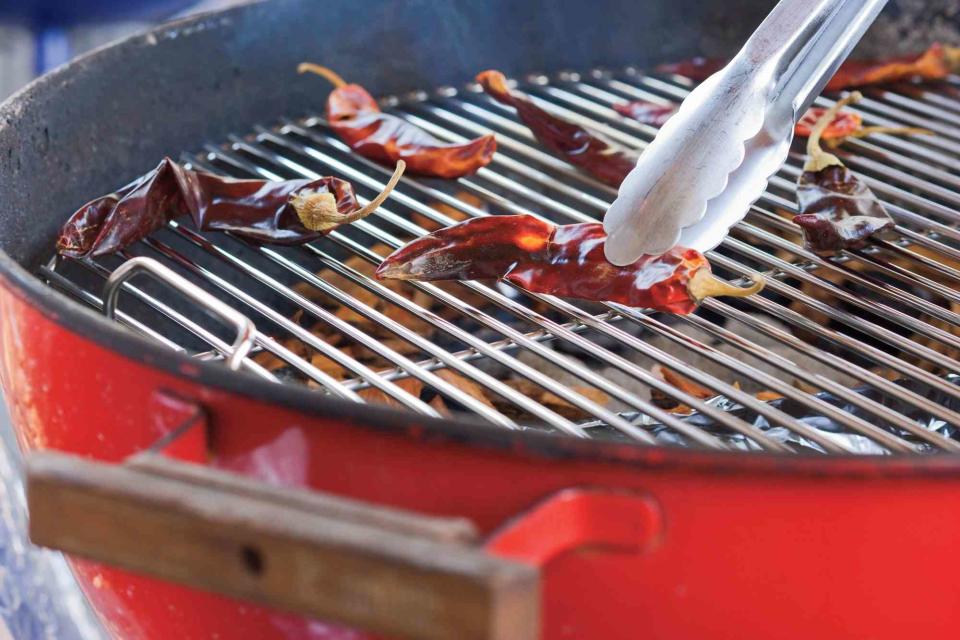A Beginner's Guide To Dried Chiles
Tips for cooking with sweet, spicy, and smoky dried chiles.

Affordable, simple to cook with, and fairly easy to find in grocery stores, dried chiles can add a lot of flavor to a dish, if you know how to use them. In Mexican cuisine, dried chiles are the backbone of many traditional dishes and while you may know how to work with their fresh counterparts, head to the spice aisle and start exploring the earthy, smoky, sweet, and complex flavors that dried chiles have to offer. Once you know how to buy, prepare, and select the right kind for a dish, the possibilities are endless.
How To Buy Dried Chiles
Supermarkets stock a decent selection of dried chiles, but for a wider selection shop at a Mexican or Latin American market. Mely Martinez, Dallas-based chef and author of The Mexican Home Kitchen, says that when buying dried chiles you need to make sure they're pliable. If they're stiff or crumble easily, then they're likely old. Another helpful thing to know about buying dried chiles is that generally the smaller the chile is, the spicer it will be.
How To Prepare Dried Chiles
First, many dried chiles have tough and bitter stems and seeds that need to be removed. To remove the seeds, cut off the stem with a paring knife or scissors, then shake out the seeds. You can also cut the chile in half lengthwise and scrape away the seeds with the back of a knife. If you have kitchen gloves, this is a great time to use them. And remember, do not touch your face, especially your eyes, when working with dried chiles.
Much like dried spices, dried chiles add more flavor to a dish when toasted or fried. You can coax out their flavor by either quickly frying dried chiles in a little oil for thirty seconds, or toasting them in an oven (or on a grill) for a few minutes until just fragrant.
Dried chiles are often pureed down into what is known as an adobo in cooking, to be added to salsas, marinades, stews, and more. But first, the chiles must be soaked in hot water until the skins soften, to yield a smooth puree and release their full flavor.
Types Of Dried Chiles
Dried chiles typically fall into one of two categories, red or dark. Red dried chiles are bright in color, more acidic, but vary greatly in spice level. These chiles pair best with chicken, pork, and fish. Darker dried chiles are purple or black in color, more moist in texture, and have the flavor of dried fruits, like raisins. They tend to be less spicy than dried red chiles and are often used for flavor, color, sweetness, or smokiness.
There are hundreds of different types of chiles, here are a few we love cooking with to get you started:
Ancho
Ancho chiles are the dried version of poblano peppers. Poblanos are often found green when sold fresh because they are picked before ripening, if left on the vine, they turn red and sweeter. When these red peppers are dried they become ancho chiles, with a wrinkly skin and dark burgundy color. They are often used in salsas or soups and stews. They're a little smoky, with a fairly mild heat, and are particularly good for marinating meats in as an adobo. Chiles mulatos are related to ancho chiles, but are darker in color; they are used to make mole poblano along with ancho and pasilla chiles.
Árbol
These tiny red chiles pack an earthy and spicy punch. Often used in salsas, their heat intensifies quite a bit when fried or toasted, so be careful with how many you use in a dish. Their name means "tree chiles" in Spanish, which refers to their woody stems. When buying these chiles, make sure that the stem is attached and that the peppers are plump, not flat, for the best flavor. These chiles, unlike other dried chiles, don't usually get their seeds removed before cooking. They're great for making homemade hot sauce and salsa.
Chipotle
Did you know that chipotle chiles are smoked and dried jalapeños? They're red because fresh jalapeños picked at the end of the ripening process are red. These dried chiles are known for their smokiness and have a medium heat. They are often made into a rich puree for marinades and braises, but can also be used to make a fresh salsa.
Guajillo
These chiles are larger than most, deep red in color, with a tough skin, and sweet flavor. They have a touch of acidity, but are fairly mild. They are very popular in Mexico, hitting the perfect balance of sweet and heat. They also go well with other chiles, as they aren't overpowering and are often paired with tomatoes.
Pasilla
Named for the Spanish word for raisins, these almost black chiles have an intense sweet, dried fruit flavor, with medium heat. They can even have a chocolate-like flavor, making them perfect for moles, but also braised beef dishes.
Pequin
Also known as a bird chiles, these tiny guys are very spicy. They're often used in fresh salsas, tamed by the acidity and sweetness of tomatoes or used to make hot sauces. You'll also see them crushed and sprinkled on fresh fruit.
How Long Do Dried Chiles Last?
If stored in an airtight container, they are used best within a few months, which is a relatively short shelf life. You'll know the chiles are old when they're brittle and have lost their aroma.
For more Southern Living news, make sure to sign up for our newsletter!
Read the original article on Southern Living.

